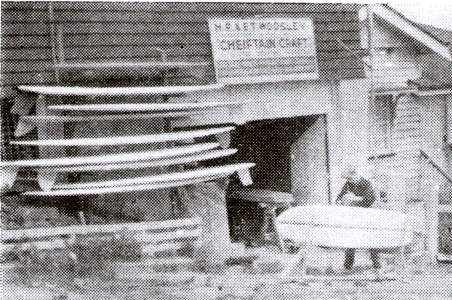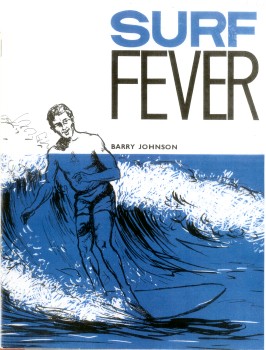 |
surfresearch.com.au
johnson : board manufacture, 1963 |
| home | catalogue | history | references | appendix |
|
From about 1940
onwards, radical changes were seen in the design of the surf board and
balsa gained popularity along the Californian coast and in Hawaii.
The surfers there
were quick to realize and appreciate the handling ability of balsa as compared
with the old laminated spruce boards used in the late 1930's.
With the introduction
of Polyeurethene to Australia in late 1959 by Barry Bennett of Sydney,
another change was seen in the method of surf board manufacturing.
Up until then
surf boards could be made by do-it-yourself enthusiasts quite inexpensively,
but nowdays the initial cost of a mould would prove too much for the average
surfer to outlay.
The poly surf
board is born inside a mould which is made of fibreglass and has steel
bands around it in order to strengthen it.
These bands are
to hold the mould in proper shape when it is clamped down and the foam
expands. Inside the mould is placed what is known as a bleeding paper,
which is a porous paper-like substance that enables the air inside the
mould to escape as the form expands and fills the entire space.
The polyeurethene
is in a liquid form and is poured into the previously prepared mould which
is clamped tight before the foam has time to expand.
Inside the mould,
the foam expands under pressure.
Once it has hardened
and set, the solid blank, as it is now known, is removed from the mould
and is placed in an oven where it is baked by an infra-red process.
This makes it
expand as much as possible.
It is well worth
remembering that polyeurethene is very unpredictable and for that reason
only skilled men undertake the baking of blanks.
Some foams expand
out of all proportion to their size, while others faint or contract through
over-baking.
After baking,
the board is split down the centre and a wooden strip is inserted and the
board is glued together again.
This strip is
usually of maple or cedar and adds strength to the board and makes it very
rigid.
The board is then
shaped.
The shaping of
surf boards is an art in itself requiring much skill and patience and an
exceptionally good eye.
There are very
few good board shapers in Australia and unfortunately for Sydney, one of
its leading shapers has left and has opened up his own board factory at
Coolangatta on the Gold Coast.
As you all know,
the general shape of the surf board in Australia, and in the rest of the
surfing world, is somewhat elliptical, tapering towards both ends.
Before the actual
shaping is commenced, the bleeding paper and about 1/8 to 1/4 inch
of skin foam is stripped from the board in 'order to reach good
workable material.
The bulk of the
surplus foam is usually removed with an ...
Page 14
... electric hand plane and the residue with a smooth plane and a sure form file, although various shapers have their own ideas as to the most suitable implements to use.
After sanding
down to remove all rough edges and to give it a smooth finish, the board
is ready to receive its fibre glass coating.
The sanded board
is first coated with resin in preparation for receiving the fibre glass
mat.
After the mat
is laid on the board and cut to the appropriate size, it is rolled so that
the resin will saturate the glass.
Another coat
of resin is applied and is rolled into the mat as before.
If needed, another
coat of fibre glass matting is laid at this stage, but this is optional,
and if not needed, the finishing coat of resin is applied.
Resin, as mentioned
above, is a chemically prepared substance which, when mixed with a promoter
and a catalyst will combine with the fibre glass to form a hard, water-proof
coating over the outside of the board.
Colours and designs
are put on the board after the last coat of resin.
They are put
on with ordinary masking tape and pigmented resin and have a specific purpose.
As all boards
have the same basic shape and look much alike, there must be some means
whereby riders are able to identify their boards - so different designs
are used.
Another reason
why boards have bright designs is to make them easily visible to the swimmer
in the water.
Unless they are
painted brightly they are very hard to see if caught in a broken wave and
can be dangerous both to the rider concerned and to other riders and swimmers.
This chapter gives
only a very brief out-line of the making of a surf board and for the protection
of the manufacturer, various technical details have been omitted.
I would point
out that it is not advisable to attempt to make a board on your own because,
should the attempt prove a failure, quite a large sum of money will go
down
the drain.
Therefore, I
suggest that to obtain a good quality board, you should see a recognized
manufacturer.
Page 26
(Surfing Personalities)
JOE LARKIN
Now in his thirties
and a former Manly beach inspector, Joe Larkin began riding surf boards
when he was only eleven years old.
Although now
semi-retired from board riding, Joe is still a great.
Regarded as one
of Australia's leading board shapers, Joe, who has worked for such men
as Bill Clymer, Gordon Woods and Barry Bennett, has now opened his own
board factory at Miles Street, Coolangatta.
Doing quite well
too, I hear.
Although heading
well on the way to being twice as old as most present day surfers, Joe
Larkin can still show even the best of them a thing or two.
He rides mainly
at Kirra and Snapper Rocks and, of course, rides a Joe Larkin board.
Page 15
 |
Sanding the Edges. Ray Woosley's factory
|
 |
Surf Fever The Jacaranda Press, Brisbane, 1963, pages 13 to 16. |

| home | catalogue | history | references | appendix |